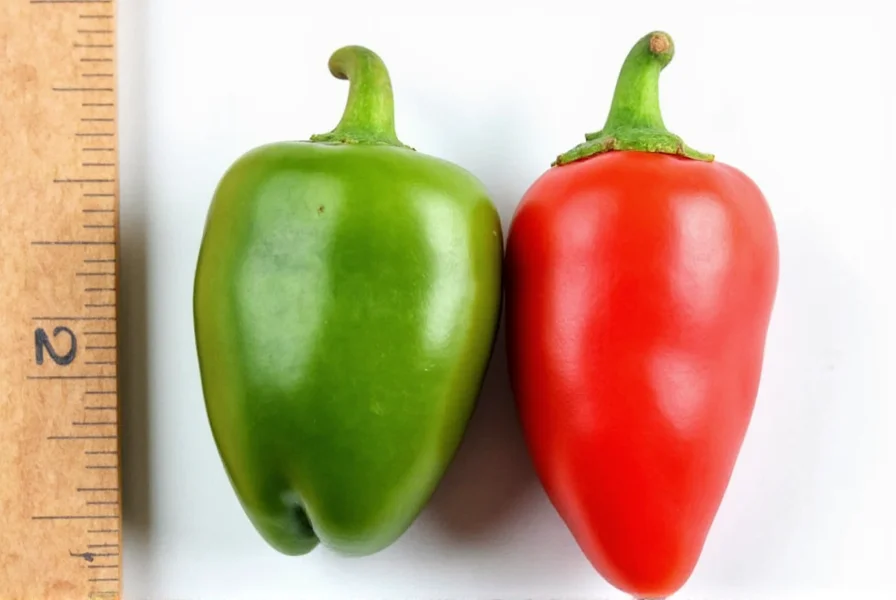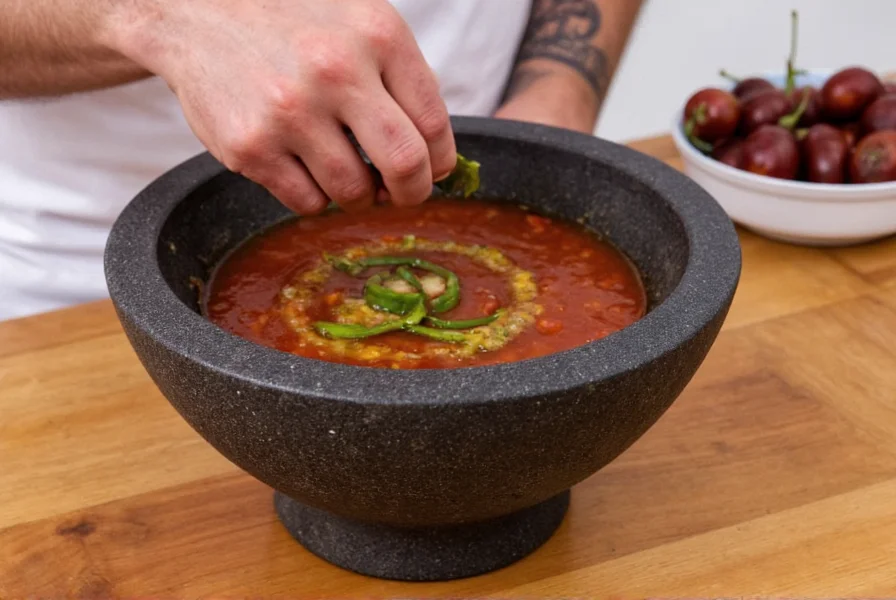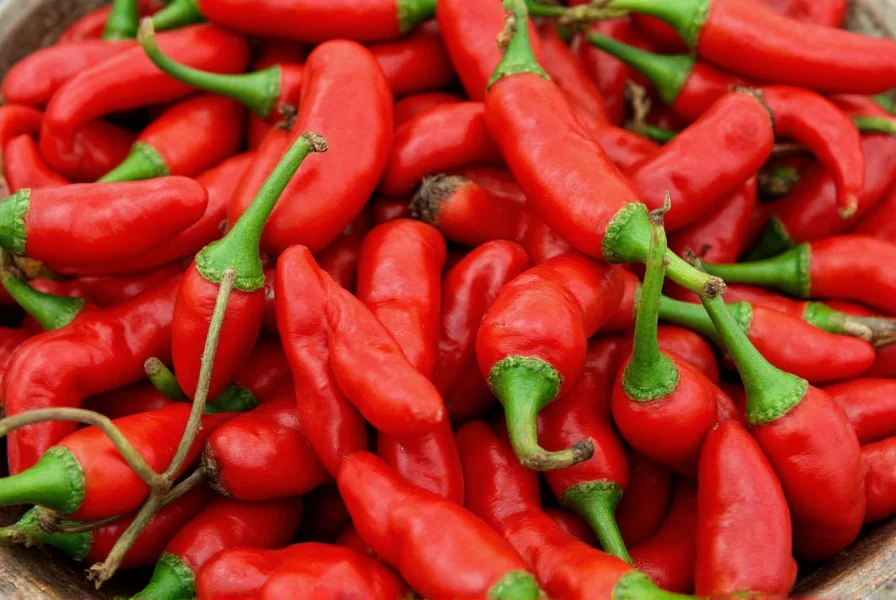Understanding what defines a Fresno chili requires examining its distinctive characteristics that set it apart from other common chili varieties. This medium-sized pepper typically measures 2-3 inches in length with a conical shape that tapers to a point. When immature, Fresnos display a vibrant green color that gradually transforms to a brilliant red as they ripen fully on the plant.
Physical Characteristics and Heat Profile
Fresno chilies share visual similarities with jalapeños but have several distinguishing features. They're generally smaller than jalapeños (which average 3-4 inches) with thinner walls and a slightly curved shape. The skin texture is smooth but somewhat wrinkled compared to the smoother-skinned jalapeño.
Regarding heat level, Fresno chilies register between 2,500-10,000 Scoville Heat Units (SHU), placing them firmly in the medium-heat category. For reference, this makes them comparable to jalapeños (2,500-8,000 SHU) but potentially hotter at their upper range. The heat distribution follows the typical chili pattern with the highest concentration in the seeds and white pith.

Fresno Chili Flavor Profile
What truly distinguishes Fresno chilies is their nuanced flavor profile. While jalapeños offer a grassier, more vegetal taste, Fresnos provide:
- A fruitier, slightly sweet undertone
- More complex floral notes
- Less bitterness than comparable heat-level peppers
- A cleaner, brighter finish
This flavor complexity makes Fresnos particularly valuable in dishes where the pepper's taste should shine through rather than simply provide heat. The green version offers a fresher, more vegetal flavor similar to unripe fruit, while the red variety develops richer, sweeter notes as it matures.
Fresno Chili vs Jalapeño: Key Differences
| Characteristic | Fresno Chili | Jalapeño |
|---|---|---|
| Size | 2-3 inches | 3-4 inches |
| Wall Thickness | Thinner | Thicker |
| Heat Range | 2,500-10,000 SHU | 2,500-8,000 SHU |
| Flavor Profile | Fruity, floral, complex | Grassy, vegetal, earthy |
| Best Culinary Uses | Salsas, sauces, fresh applications | Stuffed peppers, pickled, smoked (chipotles) |
Culinary Applications of Fresno Chilies
Chefs and home cooks value Fresno chilies for their versatility across various cooking methods. Unlike thicker-walled peppers that hold up better to stuffing, Fresnos excel in applications where their delicate flavor can permeate a dish:
Raw preparations: The green variety shines in fresh salsas, guacamole, and salads where its bright heat complements other ingredients without overwhelming them. Try finely diced in pico de gallo for a flavor-forward alternative to jalapeño.
Cooked applications: Red Fresnos develop deeper flavors when roasted or incorporated into sauces. They're ideal for:
- Arrabbiata sauce (providing heat without bitterness)
- Infused oils and vinegars
- Creamy pepper sauces for tacos and enchiladas
- Marinades for poultry and seafood
Preservation techniques: Unlike jalapeños which are commonly pickled, Fresnos maintain better texture when frozen or dried. Roast and freeze them in portions for year-round use in soups and stews.

Growing and Sourcing Fresno Chilies
Originally developed in Fresno, California (hence the name), these chilies thrive in warm climates with well-drained soil. Commercially, they're available year-round in most grocery stores, typically found alongside other fresh chilies in the produce section.
When selecting Fresnos, look for:
- Firm, unblemished skin
- Vibrant color (deep green or bright red)
- Heavy weight for their size (indicates freshness)
Store them in the refrigerator's crisper drawer for up to two weeks, or freeze them whole for longer preservation. For gardeners, Fresno chili plants produce abundant yields when given full sun and consistent watering.
Nutritional Benefits
Like all chili peppers, Fresnos contain capsaicin (responsible for heat) which has been linked to various health benefits including metabolism boost and pain relief. They're also excellent sources of:
- Vitamin C (more than oranges by weight)
- Vitamin A (especially in the red variety)
- Vitamin B6
- Dietary fiber
- Antioxidants like carotenoids
The capsaicin content may support cardiovascular health and has anti-inflammatory properties, making Fresnos not just flavorful but potentially beneficial to health when consumed regularly as part of a balanced diet.
Common Substitutions and Pairings
When Fresnos aren't available, suitable substitutes include:
- Green stage: Serrano peppers (hotter) or jalapeños (milder flavor)
- Red stage: Red jalapeños or hot cherry peppers
Fresnos pair exceptionally well with:
- Citrus (especially lime and orange)
- Cilantro and other fresh herbs
- Avocado and creamy ingredients
- Garlic and onion
- Fruit like mango and pineapple
Frequently Asked Questions
How hot is a Fresno chili compared to other common peppers?
Fresno chilies range from 2,500-10,000 Scoville Heat Units, making them medium-heat peppers. They're comparable to jalapeños (2,500-8,000 SHU) but can be slightly hotter at their upper range. They're significantly milder than habaneros (100,000-350,000 SHU) and much hotter than bell peppers (0 SHU).
Can I substitute jalapeños for Fresno chilies in recipes?
Yes, but with flavor considerations. Jalapeños make an acceptable substitute for Fresnos, though they have a grassier, less complex flavor profile. Use slightly less jalapeño than Fresno to account for potential heat differences, and consider adding a touch of citrus to mimic Fresno's fruitiness. For red Fresnos, choose red jalapeños for closest color match.
What's the difference between green and red Fresno chilies?
Green Fresnos are unripe versions of the same pepper that will eventually turn red. Green Fresnos have a brighter, more vegetal flavor with subtle heat, while red Fresnos develop richer, fruitier notes and slightly more heat as they mature. Red Fresnos also contain more capsaicin and vitamin A due to their ripeness.
How should I store fresh Fresno chilies to maximize freshness?
Store fresh Fresno chilies in the refrigerator's crisper drawer in a paper bag or perforated plastic bag for up to two weeks. For longer storage, freeze them whole after washing and drying. Unlike jalapeños, Fresnos don't pickle well due to their thinner walls, so freezing preserves their texture better than canning.
Are Fresno chilies the same as cherry peppers?
No, Fresno chilies and cherry peppers are different varieties. Cherry peppers are round and typically milder (500-2,500 SHU), while Fresnos are conical and medium-heat (2,500-10,000 SHU). Cherry peppers have a sweeter, fruitier profile, whereas Fresnos offer more complex heat with floral notes. They're not interchangeable in recipes requiring specific heat levels.











 浙公网安备
33010002000092号
浙公网安备
33010002000092号 浙B2-20120091-4
浙B2-20120091-4